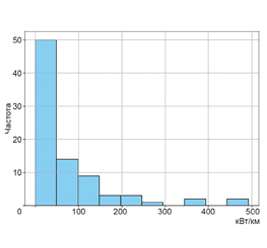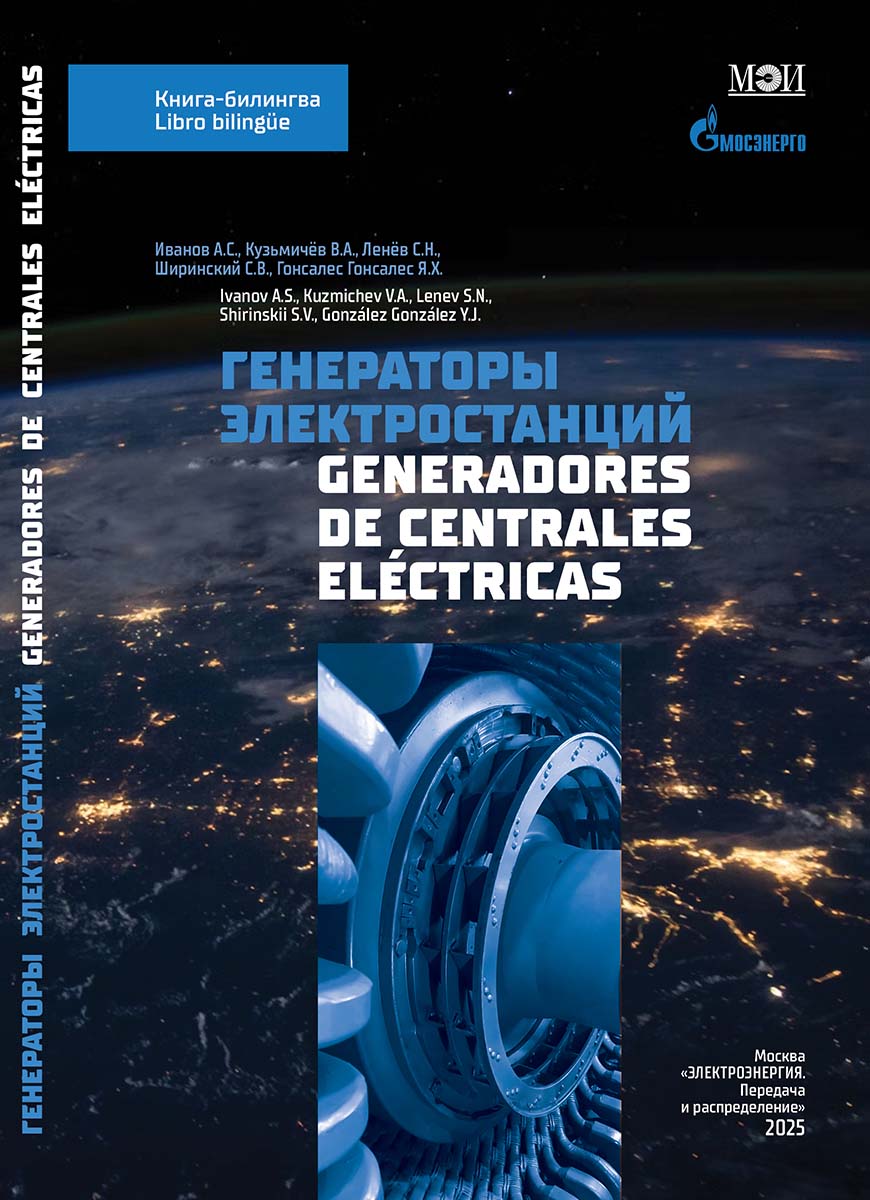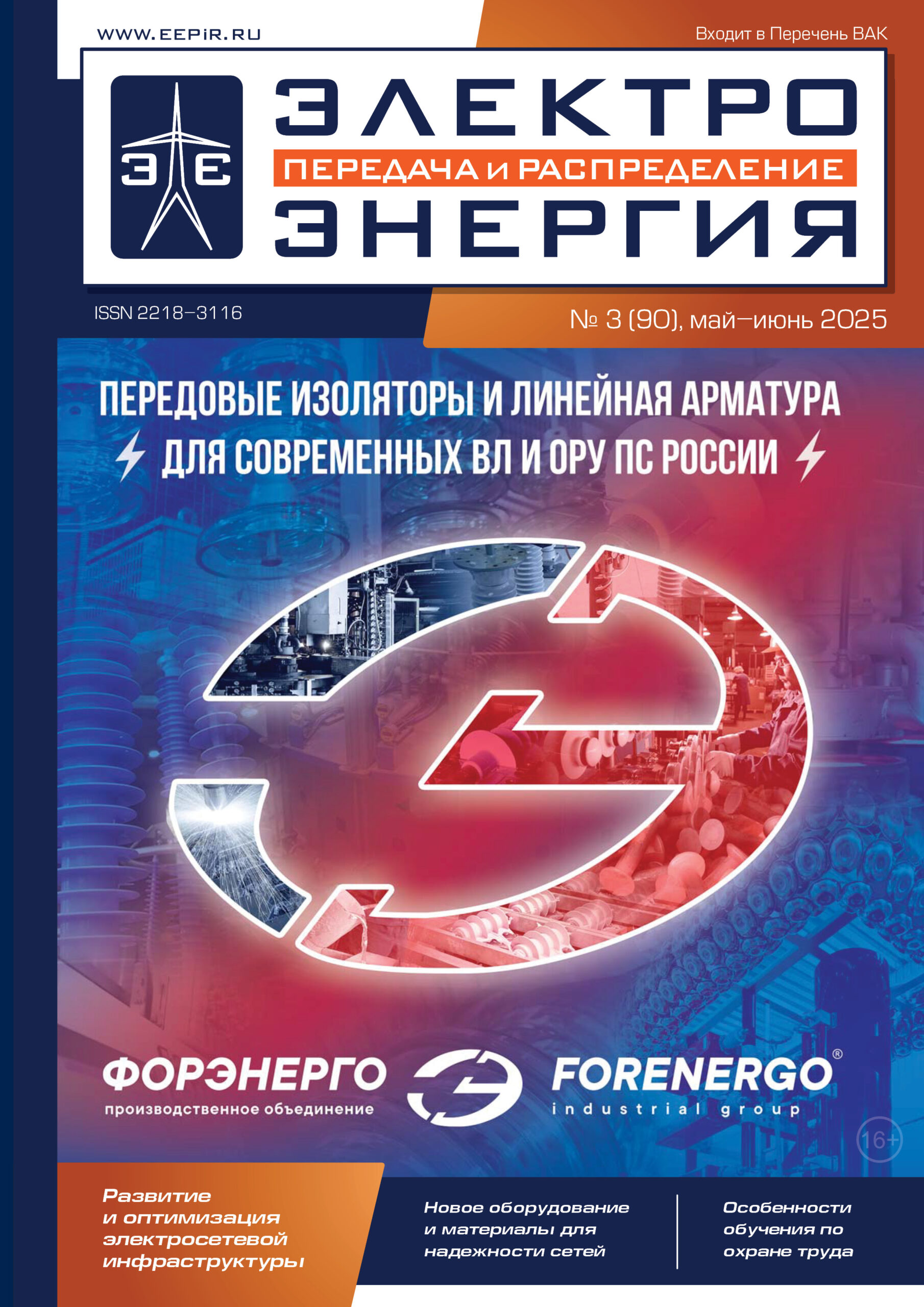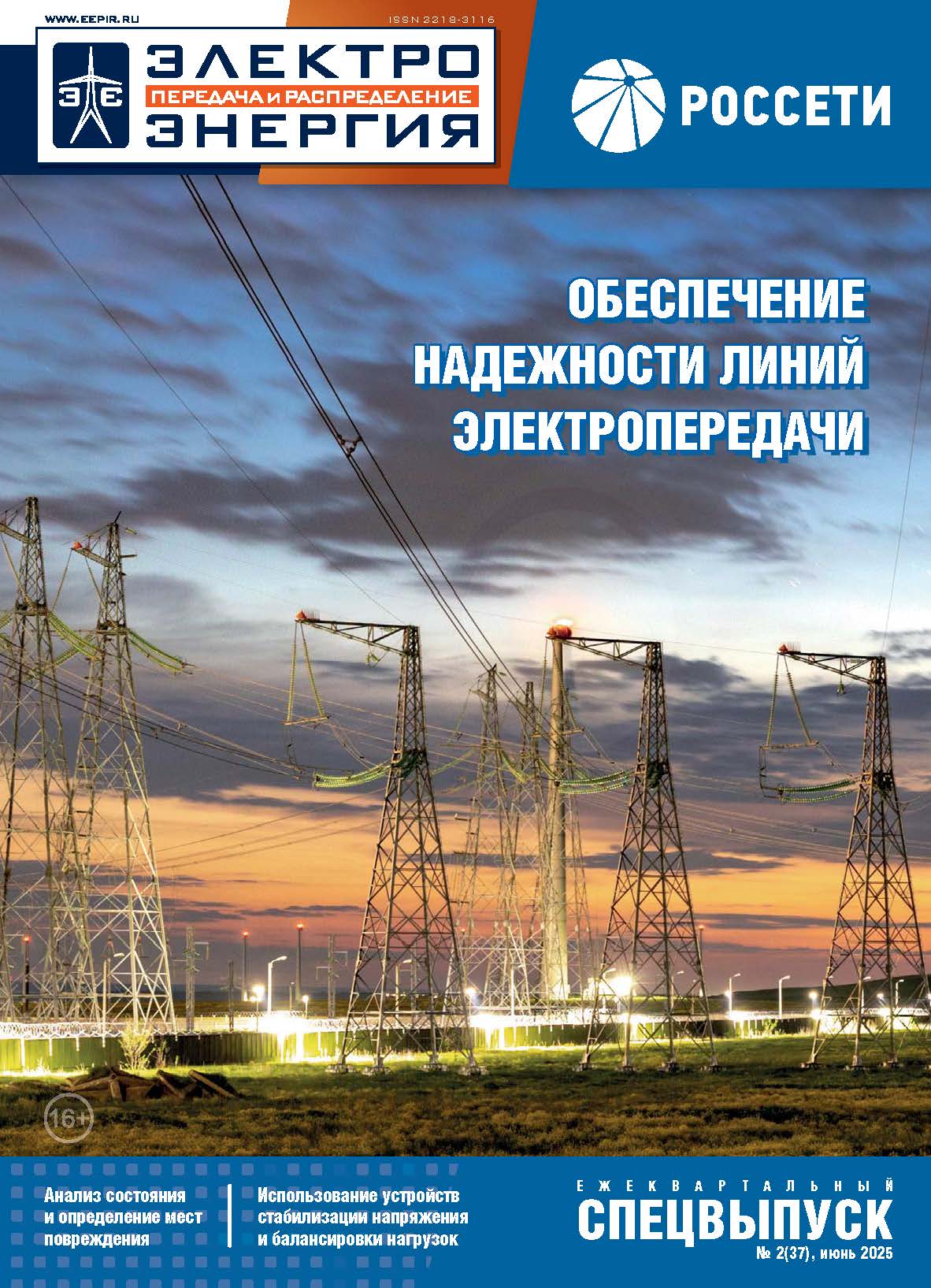
The MAIN JOURNAL for POWER GRID SPECIALISTS in RUSSIA

14
August 25–29, France, Paris
Development of Monitoring
and Control Systems in UES
of Russia on the Platform
of Phasor Measurements
Andrey ZHUKOV (
Андрей
ЖУКОВ
), Deputy Director
for UES operation control,
Dmitry DUBININ (
Дмитрий
ДУБИНИН
), Head of Department
of transient operation monitoring,
Oleg OPALEV (
Олег
ОПАЛЕВ
), Chief Specialist of Department
of transient operation monitoring, JSC “SO UES”
INTRODUCTION
Improving the ef
fi
ciency of modern systems of power
system operation supervisory and automatic control is
powered by deployment of IT-technology achievements
with the use of synchronized phasor measurements of
power system operation parameters.
In Russia the ideology of implementing synchronized
phasor measurements in technologies of UES of Russia
operation supervisory and automatic control is developed
by JSC “SO UES”. In 2005 JSC “SO — CDU UES”
initiated the creation in UES of Russia of the wide-area
measurement system (WAMS), intended for recording
time-synchronized phasor measurements of power system
operation parameters in particular nodes of UES of Russia
based on the use of synchronization signals of global
navigation satellite systems GLONASS and GPS. This
marked the beginning of phasor measurements technology
introduction in UES of Russia aimed at solving practical
control-related tasks.
In fact, WAMS combines a number of technologies
which provide:
• measuring and calculating of power system operation
parameters with high resolution and 1
μ
sec-accuracy
universal timestamp referencing;
• online data delivery in communication medium with
high degree of reliability and low level of delays to the
automated data acquisition system of JSC “SO UES”
dispatch centres;
• processing and archiving of large data volumes;
• analyzing data with the aim of revealing deviations of
monitored power system operation parameters with
respect to permissible values based on the established
criteria;
• implementation of calculation algorithms enabling
diagnostics of power equipment malfunctions,
troubleshooting of regulation systems, for example,
AEC of generators, determining parameters of
equipment equivalent circuits, in real time mode as
well, recording their dynamic pattern, etc.;
• real-time visualization of dynamic pattern of operation
parameters and visual presentation of results of
calculation tasks to dispatch and technical personnel.
Russian specialists’ research and studies of foreign
experience demonstrate advantages of implementation
of synchronized phasor measurements of power system
operation conditions for improving control methods and
algorithms aimed at increasing operation ef
fi
ciency of
control systems of the power system.
The given direction of control system development
acquires special relevance in the view of the “Energy
strategy of Russia for the period up to 2030” adopted
by the Government of RF, which provides for wide
Grid Control

15
info@eepr.ru, www.eepr.ru
integration of
fl
exible power transmission systems.
Implementation of the above-mentioned plans is oriented
at FACTS deployment in UES of Russia. New-generation
control systems that enable taking into account real-time
changes in parameters of UES calculation models, based
on laws of regulating FACTS elements and dynamic
characteristics of the power system, can only be developed
on the platform of phasor measurements of power system
operation parameters.
DEVELOPMENT OF WAMS IN UES
OF RUSSIA
Development of the wide-area measurement system in
Russia was initiated by JSC “SO — CDU UES” in 2005,
within the framework of the project “Feasibility study of
synchronous interconnection of UCTE and UES/IES” [1,
2]. The
fi
rst line of WAMS was commissioned in 2006
on 16 UES power facilities, which made it possible to
obtain data of synchronized phasor measurements, start
systematic monitoring and analysis of dynamic properties
of interconnections, conduct analysis of occurrence and
development of process disturbances and emergencies.
UES WAMS is a combination of phasor measurement
units (PMU), implemented individually or as part of
phasor recorders, phasor data concentrators (PDC), data
communication channels between power facilities and
dispatch centres of JSC “SO UES”, and data processing
means.
JSC “SO UES” carries out development of the phasor
measurement technology along the following basic
directions:
►
designing and development of Russian synchronized
phasor measurement devices:
•
development of synchronized phasor measurement
equipment
— the
fi
rst Russian PMU of MIP-01 type,
part of “Smart-WAMS” recorder, was designed by
CJSC “RTSoft” based on technical speci
fi
cations of JSC
“SO — CDU UES” in 2006. At present, synchronized
phasor measurement devices of four Russian
manufacturers (CJSC “RTSoft”, LLC “PARMA”,
LLC “ProSoft-Systems”, CJSC “Engineering Centre
“Energoservice”) operate on power facilities;
•
development of equipment intended for acquisition,
processing and communication of synchronized
phasor measurements:
○
in accordance with JSC “SO UES” technical
speci
fi
cations, CJSC “RTSoft” enabled the phasor
data concentrator function in the “Smart-WAMS”
recorder for acquisition, processing, storage and
exchange of technical data on the power-facility
level;
○
LLC “AlteroPower” designed a phasor data
concentrator to be used as part of WAMS
hardware and software suites of power facilities
and distributed automated systems of power
engineering entities for receiving and processing of
synchronized phasor measurements;
•
improvement of technical characteristics of
synchronized phasor measurement devices:
○
JSC “SO UES”, in cooperation with developers of
synchronized phasor measurement devices, works
on improving their ef
fi
ciency as regards reliability
and accuracy of measurements, increasing
the measurement sampling rate, extending
functionality, etc. They carried out works on
implementing functions of recording synchronized
phasor measurements and emergencies on the
basis of emergency event recorders PARMA RP
4.11 (LLC “PARMA”) and RES-3 WAMP (LLC
“ProSoft-Systems”), which makes it possible to
signi
fi
cantly increase the number of PMU installed
on power facilities in UES of Russia.
Synchronized phasor measurement devices, now
implemented abroad and in UES of Russia, were initially
intended for wide-area measurements (Wide Area
Measurement System — WAMS). At that, the requirements
to PMU themselves, phasor measurement communication
and processing systems did not provide for the possibility
of their use for power system control and protection.
However, advantages of implementation of the phasor
measurement technology for improvement of automatic
control systems turned out to be so substantial that at
present technical complexes of power system control and
protection based on the use of phasor measurements (Wide
Area Control System — WACS; Wide Area Protection
System — WAPS) are developed. Abroad they use the
WAMPACS abbreviation, which integrates WAMS,
WACS and WAPS [3, 11]. JSC “SO UES” has tried out
the technology of synchronized phasor measurement
data acquisition and communication to processing
centres, developed an automated data acquisition system
(WAMS ADAS), which enables on-line and off-line data
delivery to JSC “SO UES” dispatch centres, which creates
prerequisites for implementation of phasor measurement
data in control and protection systems.
A serious problem of implementing the given
developments in technical terms is meeting the
requirement to ensuring accuracy of phasor measurements
in the operation time interval of triggers (start-regulating
elements) of power system automatic control and
protection devices. One of the ways to increase the
quality of phasor measurements of power system transient
operation parameters and meet the requirement to speed
performance of triggers of automatic control devices is
ensuring accuracy of measurements alongside increasing
of calculation sampling of power system operation
parameters up to 6—12 times per mains frequency cycle.
This task is set before developers of new-generation PMU.
Evidently, various requirements to functionality of
monitoring, control and protection systems (WAMS,
WACS, WAPS) establish respective requirements to the
level of ef
fi
ciency of phasor data measurement, processing
and communication devices, too. Requirements to speed
performance of monitoring, control and protection

16
August 25–29, France, Paris
●
●
— WAMS HSS, operating online and of
fl
ine;
●
●
— WAMS HSS, operating of
fl
ine;
— phasor data concentrators in dispatch centres.
Fig. 1. Arrangement scheme of WAMS recorders in UES/IES
systems with account for the current level of technology
development are given in Table 1.
At present, there are more than 130 manufacturers
of PMU, PDC, test-bench equipment and software
for WAMS/WACS/WAPS abroad. The world leaders
in manufacture of synchronized phasor measurement
devices are such companies as ABB, Alstom Grid,
Arbiter Systems, Electric Power Group, GE Energy, Grid
Protection Alliance, OSIsoft, Schweitzer Engineering
Laboratories, Siemens, Symmetricom and others. The
operating WAMS of UES of Russia uses PMU of the
following manufacturers:
• PMU of MIP-01, MIP-02 type (CJSC “RTSoft”);
• Smart WAMS recorder (CJSC “RTSoft”);
• CRAP PARMA RP 4-11 recorder (LLC “PARMA”);
• RES-3 WAMS recorder (LLC “ProSoft-Systems”);
• PMU of ENIP-3 WAMS type (CJSC “Engineering
Centre “Energoservice”);
• PMU by CJSC “Engineering Centre Continuum”;
• PMU Power Sentinel of 1133
А
model (Arbiter
Systems, USA).
JSC “SO UES” has repeatedly conducted comparative
tests of Russian and foreign PMUs with the aim of
comparing their characteristics and assessment of
prospects of their implementation in UES of Russia. The
given tests were conducted with the use of the digital-
analog-physical complex of JSC “NTC UES” and RTDS
hardware and software suite. Based on the test results
in 2013 there were developed “Methods of conducting
PMU certi
fi
cation tests”, providing for check of PMU
characteristics in steady-state and transient operating
conditions for compliance with requirements of the
international standard IEEE
С
37.118.1-2011.
►
Development of regulatory and methodical base
for implementation of synchronized phasor
measurements:
• requirements to phasor measurement units and
WAMS hardware and software suites (WAMS HSS)
Table 1. Requirements to speed performance of
monitoring, control and protection systems of the
power system
of
fl
ine
ADCS
WAMS
of
fl
ine
not
regulated
Steady-state and
transient processes
real
time
WAMS
online
t < 5 sec
ACS
(online)
WACS
t < 5 sec
Steady-state
operation
WAPS
t < 1 sec
Electromechanical
transients
РЗ
t << 1 sec
Electromagnetic
transients
Grid Control

17
info@eepr.ru, www.eepr.ru
of power facilities were
developed;
• “Methods and program of
phasor measurement unit
certi
fi
cation tests” were
developed and tried out in
practice;
• requirements to organization
of transients monitoring
in power systems for
emergency control tasks
were introduced into the
National standard of RF
(GOST R 55105-2012)
“Supervisory Control.
Automatic emergency
control of power system
operation. Automatic
emergency control devices of power systems.
Speci
fi
cations and regulations”;
• principles and order of interaction between power
engineering entities during organization of WAMS HSS
operation, development of new suites or modernization
of existing ones are speci
fi
ed in the standard of JSC
“SO UES” (STO 59012820.29.020.002-2012) “Relay
protection and automation. Interaction of power
engineering entities and electric power consumers
in creation (modernization) and organization of
operation”.
►
Organizing works on designing and integrating
WAMS HSS on power facilities:
• in cooperation with JSC “Rosenergoatom Concern” and
CJSC “ENPRO”, a project of WAMS HSS creation on
Beloyarsk, Kalinin, Kursk, Novovoronezh, Smolensk,
Rostov, Leningrad and Kola nuclear power plants was
developed and implemented;
• System projects of WAMS development in
Interconnected energy systems of Urals and Siberia
were developed;
• in accordance with requirements to organization of
WAMS in power systems for emergency control tasks,
WAMS HSS are designed for newly commissioned and
reconstructed operating power facilities (arrangement
scheme of WAMS recorders in shown in Fig. 1).
The increase in the number of installed WAMS
complexes on power facilities and PMU in the period
from 2005 to 2013 and prospects up to 2020 are shown in
the diagram (Fig. 2).
►
Creation of the automated on- and off-line data
acquisition system for supervisory and automatic
control of power systems
One of relevant tasks in the process of creating
WAMS in UES of Russia is developing and integrating
of an automated phasor measurement data acquisition
system in dispatch centres of JSC “SO UES” that provide
communication of large volumes of data with high
reliability and minimal time delays. Works on development
PMU
WAMS HSS
1000
900
800
700
600
500
400
300
200
100
0
2006 2007 2008 2009
2010 2011 2012
2013 2014 2015 2016
2017 2018 2019
2020
Fig. 2. Prospects of integrating WAMS suites on power facilities
of the given system were conducted by specialists of JSC
“SO UES” in cooperation with LLC “AlteroPower”, and
in 2012 WAMS ADAS was commissioned in dispatch
centres of JSC “SO UES” (the schematic overview of the
data acquisition system is shown in Fig. 3). Deployment
of WAMS ADAS in JSC “SO UES” will lead to:
• creation of a complex infrastructure, on the basis of
which the technology of automated online and of
fl
ine
data acquisition from WAMS recorders for dispatch
centres of JSC “SO UES” was implemented;
• enabling systematic acquisition of data of WAMS
recorders in the event of process disturbances and
emergency situations in UES of Russia;
• enabling the possibility of developing control
technologies, which use phasor measurement data of
power system operation parameters, on the basis of
WAMS ADAS.
►
Development of power system supervisory
and automated control on the basis of phasor
measurements
The main aim of developing the technology of
synchronized phasor measurements is improving quality
and reliability of power system supervisory and automated
control. In this connection JSC “SO UES” initiated
development and deployment of the following systems:
• to enable max. capacity of transmission lines with
account for actual power system operating conditions,
estimate stability margin in monitored grid sections in
real-time mode, the Stability margin monitoring system
(SMMS) was developed and commissioned in northern
areas of Tyumen Region, which required installation of
PMU on six power facilities and organization of the
phasor data acquisition system in Tyumen regional
dispatch of
fi
ce [4, 5].
Works on further development of SMMS functionality
are conducted; new-generation SMMS complexes were
put into pilot operation in the North-West IES in two JSC
“SO UES” branches. Integration of the new-generation
SMMS will make it possible:
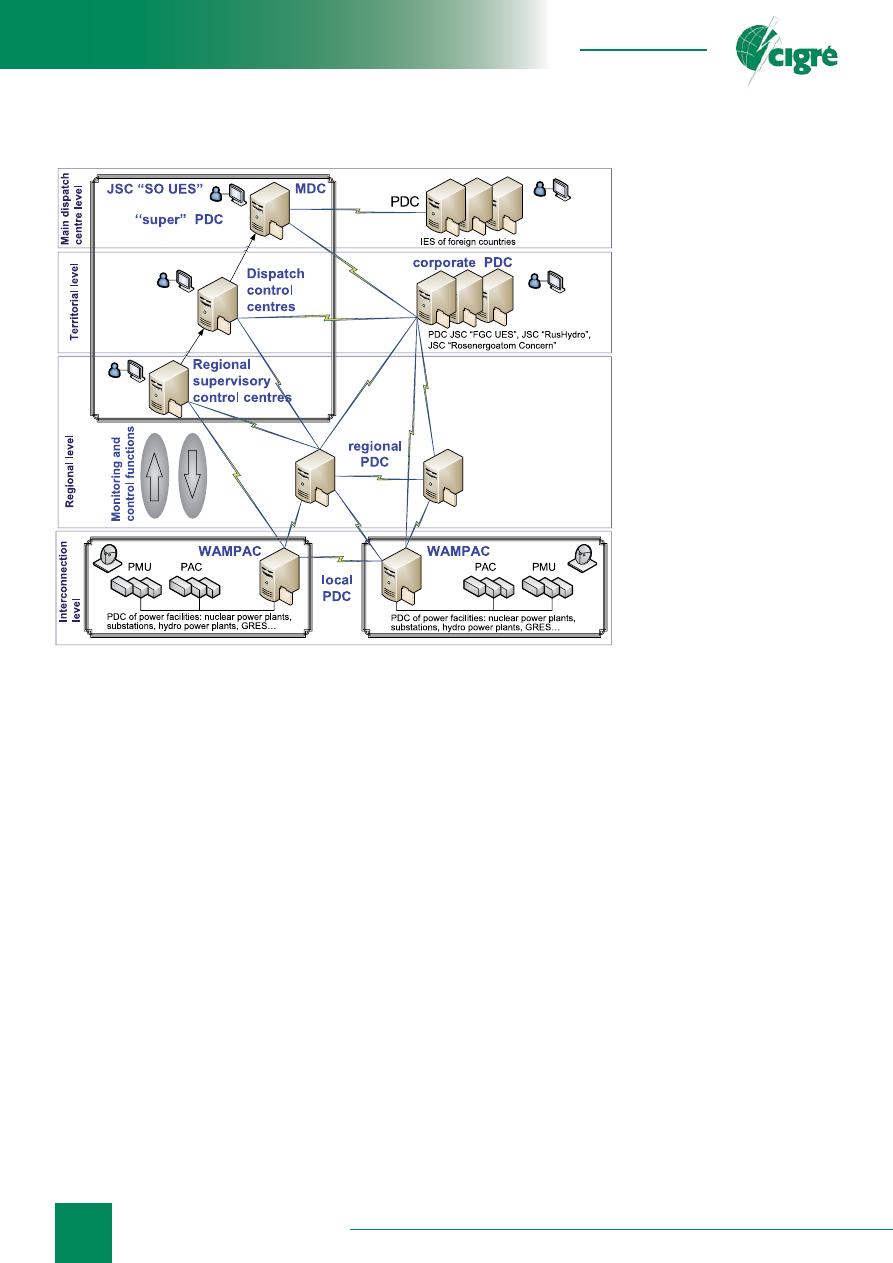
18
August 25–29, France, Paris
○
to use grid capacity to its maximum while ensuring
regulatory stability margin by controlling operation
with account for actual operating conditions and
current limitations and emergency control resources;
○
to provide the dispatcher in real-time mode with
actual values of emergency-state permissible and
maximum permissible active power exchanges in the
grid in various power system operating conditions;
• with the purposes of monitoring operation of excitation
systems and automatic excitation regulators of
generators at power plants, a pilot project of the system
regulator monitoring system (SRMS) at the North-
West power plant was developed and implemented
with support of JSC “Inter RAO” [6].
SRMS basic functions are prompt identi
fi
cation of
generation equipment with malfunctioning excitation
systems, which can cause emergency situations in the
power system, diagnostics of sustained low-frequency
synchronous oscillations (LFO) of generators to ensure
proper operation of system stabilizers, estimation of the
required extent of adjusting AEC settings, troubleshooting
the excitation system of synchronous generators, etc.
Pilot operation of the system at the North-West power
plant made it possible to reveal inef
fi
cient operation of
system stabilizers and make required adjustment of the
settings.
At present, in cooperation with LLC “LUKOIL-
Kubanenergo”, the company works on SRMS development
and deployment at Krasnodar
power plant:
• in order to analyze dynamic
properties of the power system,
diagnose LFO in different parts
of UES of Russia, identify
sources of process disturbances
and estimate the degree of
the hazard they pose for the
power system, LFO monitoring
methods and algorithms
are developed. It is planned
to complete works on its
integration with WAMS ADAS
in 2014;
• in order to increase the
accuracy of calculations in
power system state estimation
programs, works on extending
scope of implementation
of synchronized phasor
measurements in hardware and
software suites of centralized
systems of emergency control
automatics (CS ECA) are
carried out.
►
Support of WAMS HSS
operation on power facilities
JSC “SO UES” supervises
WAMS HSS development and integration processes on
power facilities, establishes technical speci
fi
cations of
the suites, coordinates statements of work and design
documentation, participates in acceptance of suites for
operation and, by means of WAMS ADAS, monitors
operation of the suites after their commissioning.
At present, JSC “SO UES” uses synchronized phasor
measurement data:
• to analyze process disturbances and emergency
situations (post-emergency analysis);
• to monitor correct operation of system regulators;
• to verify calculation models [7, 8];
• to monitor participation of power generation units in
general primary frequency control and rated primary
frequency control;
• to assess UES frequency characteristics during
fi
eld
tests;
• to increase accuracy of state estimations;
• to specify static and dynamic characteristics of the
power system;
• to analyze LFO and identify their parameters;
• to estimate stability margins in monitored grid sections.
While solving the above mentioned tasks, JSC
“SO UES” actively cooperates with Russian and
foreign partners, including JSC “NTC UES”, JSC
“Energosetproyekt Institute”, Moscow Power Engineering
Institute, Institute of Energy Systems of RAS Siberian
Branch, CJSC “RTSoft”, LLC “PARMA”, LLC “ProSoft-
Fig. 3. Schematic overview of UES/IES WAMS data
acquisition system
Grid Control

19
info@eepr.ru, www.eepr.ru
Systems”, LLC “AlteroPower”, CJSC “Engineering
Centre “Energoservice”, Alstom Grid, Psymetrix, Elpros,
SC B5 CIGRE “Protection and Automation” committee,
Very Large Power Grid Operators and others.
By now, 51 WAMS suites have been commissioned in
UES of Russia, the number of PMU is 262. For the period
of 2014—2015 it is planned:
• to integrate WAMS HSS at Beloyarsk Nuclear
Power Station-2, Konakovskaya GRES, CHPP-
16 and 26 Mosenergo, Nevinnomysskaya GRES,
Votkinsk Hydroelectric Station, Serovskaya and
Nizhnevartovskaya GRES, Kaliningrad CHPP-2, and
a number of JSC “FGC UES” substations;
• to update the existing WAMS complexes of 1150 kV
substation Altai, Sayano-Shushenskaya Dam, Zagorsk
pumped storage station, Kalinin, Kursk, Novovoronezh,
Rostov and Smolensk nuclear power plants.
According to preliminary estimates, by the end of
2015 WAMS complexes will be deployed on more than
80 power facilities (more than 400 PMU), while by
2020 — on 200 UES of Russia power facilities (more
than 1000 PMU).
MAIN DIRECTIONS AND PROSPECTS
OF IMPLEMENTATION OF SYNCHRONIZED
PHASOR MEASUREMENTS
IN PRACTICAL TASKS
WAMS ADAS deployment in JSC “SO UES” and
increasing number of installed PMU and PDC on power
facilities enable using synchronized phasor measurement
data in practical tasks. The technology provides more
accurate (both by the values of measured parameters
and measurement time synchronization) data, comparing
to existing telemetry systems, and the main task for
development and implementation of its potential is
designing new software and adapting the existing one
(software applications) with the aim of improving power
system control reliability and quality. In world practices
all tasks based on phasor measurements are provisionally
divided into two main categories:
• analytical and calculation applications using archive
information (of
fl
ine);
• tasks of real-time power system operation monitoring
and control (online).
Analysis of foreign publications as regards
implementation of synchronized phasor measurements for
power system control tasks demonstrates the following
directions of their use in System operators and power
companies:
• for supervisory control and automated emergency
control tasks:
○
monitoring of emergency triggering conditions
with the aim of taking measures on their prevention
and control;
○
control of power
fl
ows in the grid with account for
relative angle, as well as presence and level of low-
frequency oscillations;
○
identifying of the place of emergency separation of
the power system and further synchronization of
the sections;
○
dispatcher’s situational awareness (visualization of
dynamic pattern of operation parameters, integration
of analysis results with various visualization
means);
○
monitoring of voltage load stability;
○
improving of state estimation accuracy;
○
calculation and graphic visualization of reactive
power reserves, etc.;
• for tasks solved by technical personnel (specialists of
power system operation control, relay protection and
automation services):
○
analyzing of process disturbances and emergency
situations (post-emergency analysis);
○
monitoring of operation of system regulators;
○
monitoring of participation of power generation
units in primary frequency control;
○
estimation of UES frequency characteristics during
fi
eld tests;
○
increasing accuracy of calculating maximum
permissible exchanges;
○
verifying of calculation models;
○
improving of state estimation accuracy;
○
specifying of static and dynamic properties of the
power system;
○
localizing faults in transmission lines and identifying
kinds of faults;
○
specifying parameters of equivalent circuits of
transmission lines, power equipment and consumer
load [9];
• for tasks solved by personnel of power companies:
○
monitoring of operation of system regulators;
○
analyzing of process disturbances and emergency
situations;
○
diagnostics of state of transmission lines and power
equipment;
○
monitoring of electric power quality;
○
fault localization, etc.
Possibilities of WAMS technology implementation
in application tasks, being of interest for backbone
grid companies and, to some degree, distribution grid
companies, are given in [10, 11, 12].
Among promising R&D works conducted now by JSC
“SO UES”, one can distinguish the following.
WORKS ON PROVIDING REAL-TIME
MONITORING OF LOW-FREQUENCY
OSCILLATIONS
Monitoring of low-frequency oscillations is one of
the most widely spread applications in the world based
on synchronized phasor measurement data. One function
of such applications is identifying the modal composition
of operation parameters, oseillations dominant local and
interzone modes and estimation of parameters of low-
frequency oscillations, including damping factors to
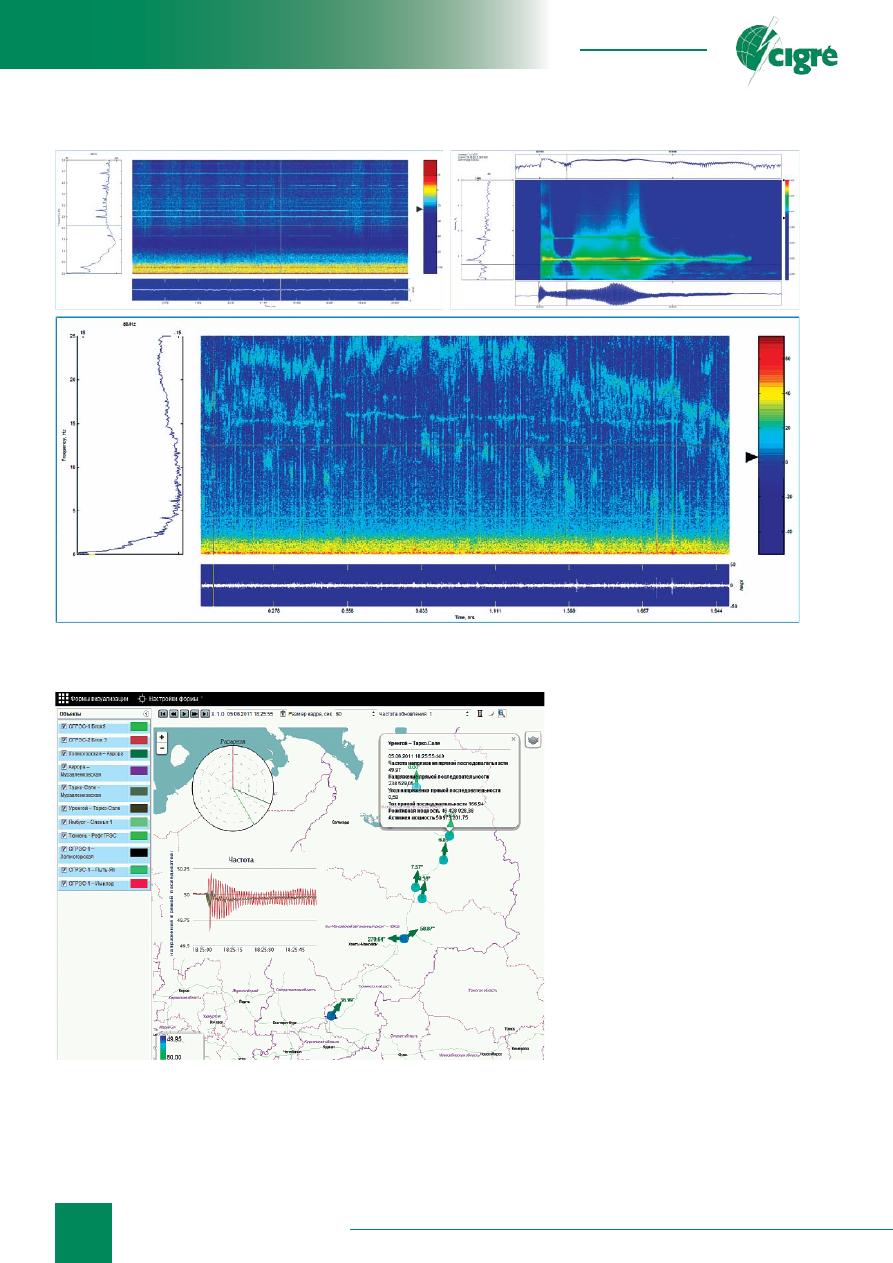
20
August 25–29, France, Paris
Fig. 5. Screen form of the application “Monitoring of low-
frequency oscillations”
estimate oscillatory stability level.
Since 2006 JSC “SO UES” has been conducting
monitoring of low-frequency oscillations with the aim
of analyzing dynamic properties of the power system, as
well as identifying “problematic” places and developing
guidelines on changing forced control automated excitation
Fig. 4. Current frequency and active power spectrograms of the grid in UES of Russia
regulator settings and optimizing settings
of AEC systemic stabilization channels on
operating power facilities. Low-frequency
system oscillations and exceedence of
certain levels by their parameters can
lead to improper parallel operation of
power plants and power systems. Besides,
permanent under-damped oscillations of
power system operation parameters in one
part of the interconnection, being a periodic
disturbance, can cause oscillations in
another part of the interconnection and
also cause instability. Since at present
FACTS elements are not implemented
for damping oscillations of power system
operation parameters, almost the only
means of damping oscillations is system
stabilizers included in automatic excitation
regulators of synchronous generators at
power plants.
Work on developing LFO monitoring
software suite on the basis of WAMS
ADAS was initiated in 2013. Dominant
LFO modes in the daily frequency spectrum of Kola nuclear
power plant, in the frequency spectrum during synchronous
swings of power generation units of Surgutskaya GRES-
2 (05.06.2011 16:24—16:34) and in active-power
spectrum of 500 kV OHL Sayano-Shushenskaya Dam-
Novokuzneskaya 2, which re
fl
ect impact of an aluminum
Grid Control
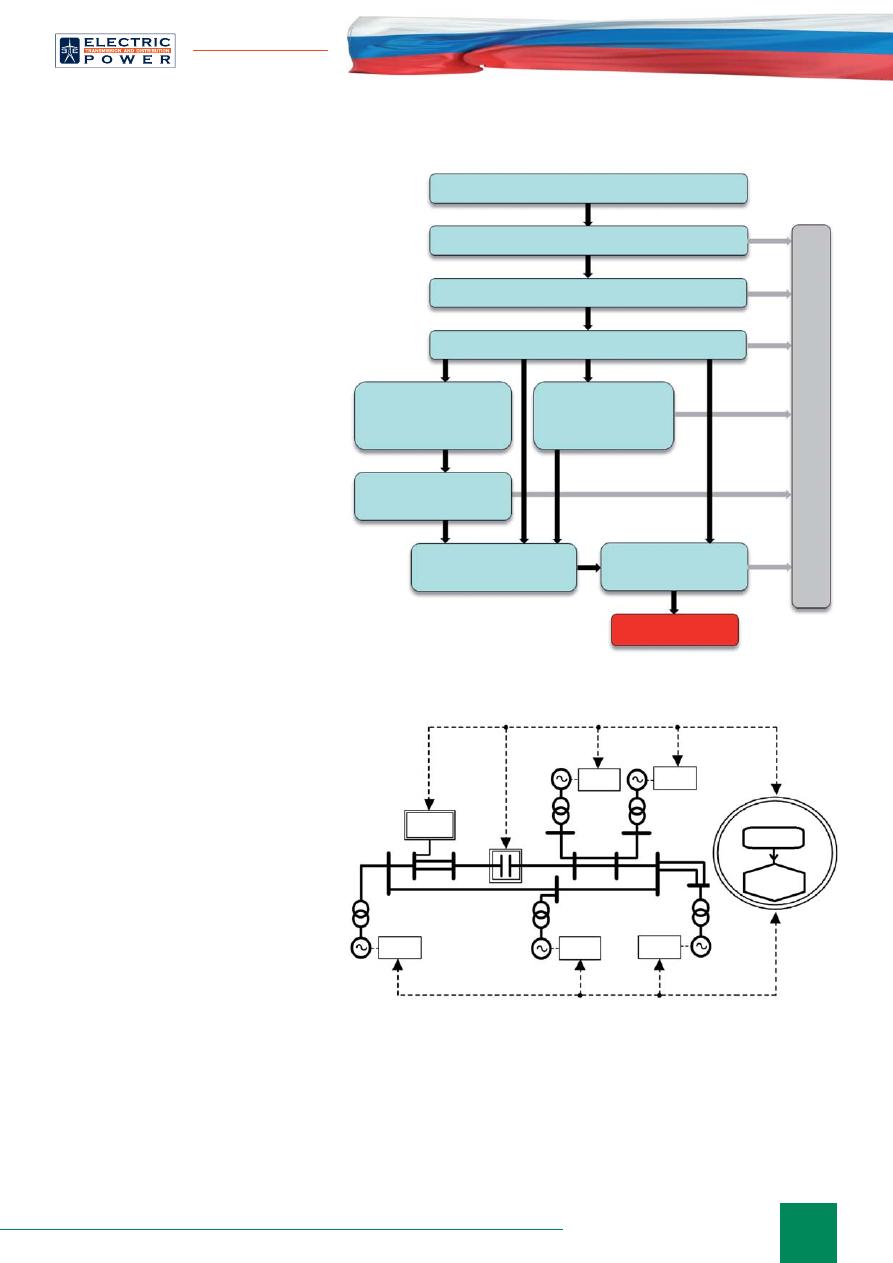
21
info@eepr.ru, www.eepr.ru
plant load on spectral properties of power
system operation parameters, are shown
as provisionary results of WAMS data
analysis in Fig. 4.
Software developers have the task of
designing an automatic tool for real-time
monitoring of low-frequency oscillations
(one of application screen forms is shown
in Fig. 5). The main advantage of such
a system is the possibility of prompt
identi
fi
cation of the most hazardous
zones and oscillation transits, obtaining
comprehensive information about current
parameters of oscillations in a convenient
visual form and conducting statistical
analysis of changes in UES of Russia
spectral properties.
Fig. 6 shows the operation algorithm
of the “Monitoring of low-frequency
oscillations” application included in
WAMS ADAS.
At present works on analyzing
frequency spectra, identi
fi
cation of
dominant modes of power system
operation parameters in different parts of
UES of Russia are conducted, with the
aim of identifying sources of LFO and
developing measures on their reduction
(elimination). One of possible technical
solutions for implementation of results
of the given task is using the algorithm
of adaptive adjustment of settings
of automatic excitation regulators of
synchronous generators at power plants
based on the hazard level of recorded
LFO (Fig. 7).
DEVELOPMENT
OF SOFTWARE SUITES FOR
POWER SYSTEM OPERATION
MONITORING BASED
ON WAMS DATA
In connection with signi
fi
cantly
increasing information volumes, one of
relevant tasks of improving supervisory
control quality is optimizing information
presentation to dispatch personnel,
including visualization of power system
operation parameters and condition of power equipment of
power facilities and transmission lines. Works in the
fi
eld
of development and improvement of software products
enabling adequate demonstration of processes in the
power system on the basis of phasor measurements and
increasing speed of dispatcher’s response are nowadays
conducted abroad by such companies as Alstom Grid,
OSIsoft, ELPROS d.o.o., ABB, Siemens, PowerWorld
and others. One of the most functional software products
that use phasor data of power system operation parameters
is RTDMS (Real Time Dynamic Monitor System, USA),
installed in dispatch centres of all System operators of
the USA (Fig. 8). Specialists of JSC “SO UES” study
such foreign practices to assess the possibility of using
the technologies for supervisory control tasks in UES
of Russia. For example, within the framework of a pilot
project, they examined functionality of WAProtectorTM
software, developed by ELPROS d.o.o. (Slovenia). It is
Fig. 6. Operation algorithm of the application “Monitoring of
low-frequency oscillations”
Data preparation
Spectral analysis
LFO identi
fi
cation
Mode analysis
Correlation analysis
of dominant
modes
Estimation of SG
participation level
Gradation of
dominant modes
Identi
fi
cation
of permanent
modes
Estimation of mode
hazard
ALARM
DA
TABASE, information visualization
Fig. 7. Schematic overview of the algorithm of adaptive
adjustment of AEC settings based on LFO level
AEC
AEC
LFO
AEC adaptive
adjustment
WAMS ADAS
AEC
AEC
ES-4
ES-3
ES-2
SRPC
ES-1
SS
№
1 SS
№
2
TCSC
ES-5
AEC
SS
№
3 SS
№
4 SS
№
5

22
August 25–29, France, Paris
planned to test PhasorPoint software (Psymetrix, Alstom
Grid) in 2014. Study of foreign experience does not
exclude the need in developing Russian solutions for using
phasor recording technologies based on knowledge of
operation peculiarities of UES of Russia and accumulated
experience in supervisory and automated control of UES
of Russia.
The main prerequisite of developing PC-monitoring
of the power system based on WAMS
data is the current level of modern
software designed for processing and
displaying of large volumes of data
capable of providing JSC “SO UES”
dispatch and technical personnel not only
with standard visualization of dynamic
pattern of power system operation
parameters, but also with dispatcher’s
situational awareness, by giving access
to calculation and analytical information
of various applications using WAMS
database. The dispatcher will be able to
obtain comprehensive information about
emergencies and their causes, process
characteristics and to access the required
calculation and analytical information
described earlier.
JSC “SO UES” has developed
prototypes of visualization forms of
displaying dynamic pattern of power
system operation parameters in normal
operation mode and in the event of process
disturbances and emergency situations
across the UES of Russia (Fig. 9, 10, 11).
Measurement synchronization enables
graphic visualization of real transient
processes within UES of Russia, which
implements the principle of global
monitoring. Such software products
are used in power systems of the USA,
China, Spain, etc. Figuratively speaking,
the technology takes a multitude of
Fig. 8. RTDMS screen forms
Fig. 9. Distribution of voltage relative angles across UES
Fig. 10. Frequency sweeps at Surgutskaya GRES-2 and
identi
fi
cation of parameters of low-frequency oscillations
consecutive snapshots of the state of the power system,
enables visualizing the dynamic pattern of operation
parameters and provides the dispatcher with a clear picture
of processes taking place in the power system.
Visualization of the dynamic pattern of operation
parameters is a promising R&D direction and can be used
to solve the following supervisory control tasks:
• identi
fi
cation of a process disturbance and its location;
Grid Control
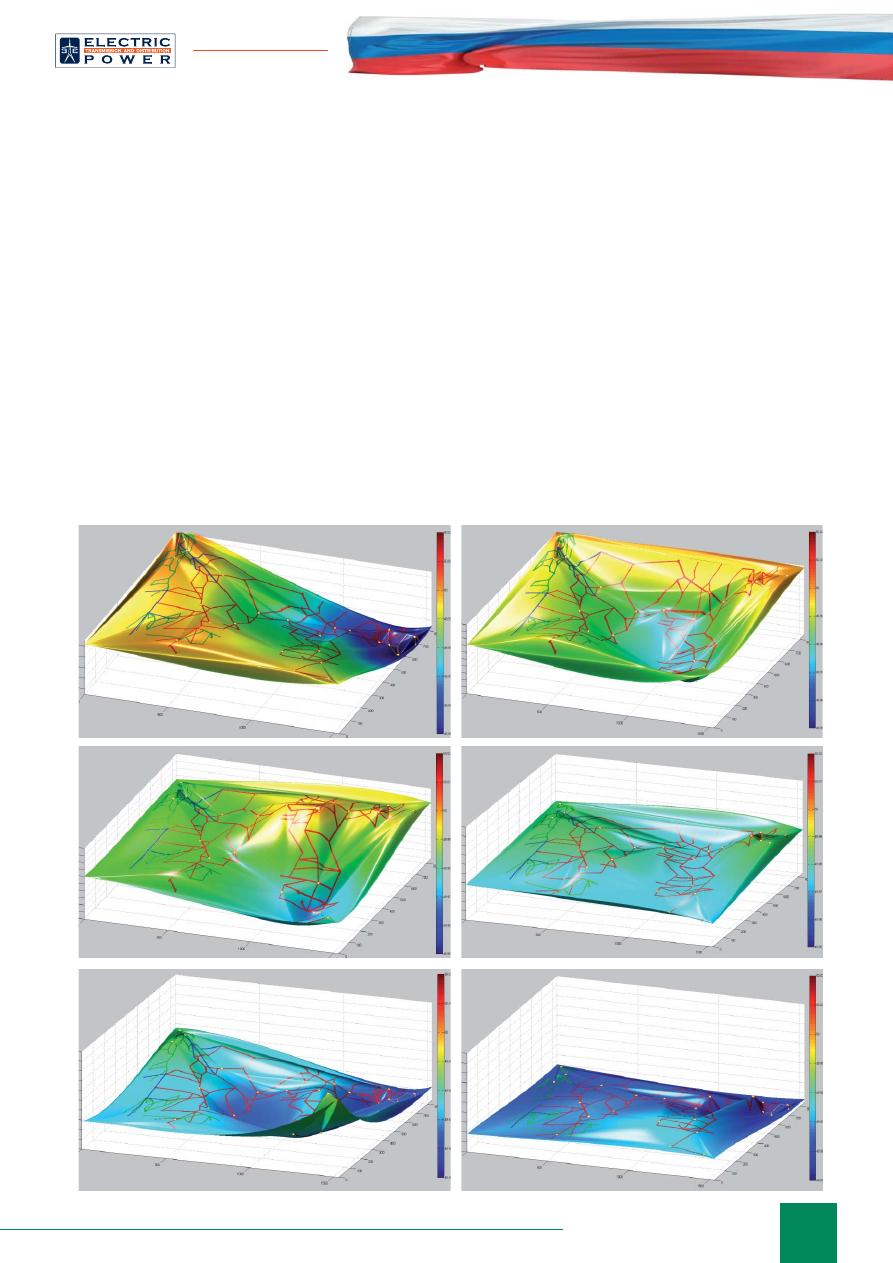
23
info@eepr.ru, www.eepr.ru
• monitoring of the process of occurrence and
development of synchronous (asynchronous) swings;
• monitoring of power system separation into sections;
• monitoring of dynamic properties of the power system
and its particular nodes;
• post-emergency analysis of process disturbances;
• emergency response drills of dispatch personnel, etc.
CONCLUSION
Summarizing on provisional results of development
and implementation of synchronized phasor measurement
technology in UES of Russia, the following conclusions
can be drawn:
• JSC “SO UES” acts as an ideologist and coordinator of
development of the synchronized phasor measurement
technology for monitoring and control tasks in UES of
Russia;
• the strategy of development and deployment of
phasor measurement technology is directed at solving
practical tasks of monitoring and improving ef
fi
ciency
of control in UES of Russia;
• development of the synchronized phasor measurement
technology in UES of Russia is carried out by Russian
specialists with account for experience accumulated
abroad;
• at present, there is a technology platform in Russia
enabling use of on- and off-line phasor measurements
of operation parameters in practical supervisory and
automated control tasks;
• regulatory and methodical base developed by JSC
“SO UES” enables designing and deployment of
WAMPACS systems on newly commissioned and
reconstructed power facilities of UES of Russia;
• JSC “SO UES” conducts constant monitoring of
developed UES WAMS. Data of phasor measurements
are used to analyze operating conditions of the power
Fig. 11. Process of frequency-wave propagation across UES upon disconnection of a power generation
unit of Nizhnevartovskaya GRES (795 MW imbalance)
0
с
5
с
1
с
4
с
3
с
2
с

24
August 25–29, France, Paris
Grid Control
system, its dynamic properties during system tests,
disturbances and emergency situations in the power
system;
• JSC “SO UES” has developed, deployed and is
improving technologies of automated grid stability
margin monitoring and monitoring of operation of
system regulators at power plants, operating in real-
time mode. Works on implementation of the phasor
measurement technology in development of modern
emergency control automatics are conducted;
•
JSC “SO UES” coordinates efforts of Russian
developers directed at improvement of hardware
of synchronized phasor measurement devices,
establishes requirements to functionality and technical
speci
fi
cations of recorders and arranges PMU tests;
• JSC “SO UES” outlines the ideology and develops
software for analyzing UES of Russia dynamic
properties, diagnostics and identi
fi
cation of low-
frequency oscillations, estimation of damping
properties of the power system for their further use in
supervisory and automated control tasks.
Among the nearest-term tasks of developing control
technologies in UES of Russia based on WAMS phasor
measurement data, the following can be enumerated:
• research related to implementation of synchronized
phasor measurements of operation parameters in
control systems in conditions of deploying elements of
active-adaptive grids in UES of Russia;
• development of adaptive algorithms of choosing
controlling impacts of automated normal and
emergency operation control systems in UES of Russia
on the platform of modern IT-technologies and phasor
measurements of power system operation parameters;
•
development of new-generation Russian phasor
measurement units in order to use them as triggers
(start-regulating elements) in automated normal and
emergency operation control systems in UES of Russia
(WACS, WAPS);
• development of methods and software for online
actualization of equivalent circuit parameters of power
system elements based on current phasor measurements
data for their use in calculation tasks of automated
control systems;
• development of a package of applications for the
“Dispatcher’s Advisor” software suite, which includes
software for analysis and estimation of current
operating parameters of the power system, forecasting
consequences of their worsening and visualization of
the dynamic pattern of operation parameters and their
trends, etc.;
• development of JSC “SO UES” standard “Requirements
to the system of phasor recording of power system
operation parameters for tasks of supervisory and
automated control of UES of Russia”;
• development of type design solutions for hardware
and software suites of recording operation parameters
of transmission lines and power equipment;
•
involvement of power engineering entities in
development of technology tasks related to estimation
of operation state and remaining life-time of power
equipment, proper operation of regulation systems
based on synchronized phasor measurement data, etc.
REFERENCE LITERATURE
1. B.I. Ayuev. About the Wide Area Measurement System /
Energorynok,
№
2, 2006.
2. N.G. Shulginov, L.A. Koshcheev, A.V. Zhukov, A.T.
Demchuk. Improving operational reliability of UES
of Russia by means of automatic emergency control
devices — Papers of 43rd CIGRE session, 2010.
3.
A.V. Zhukov, A.T. Demchuk, D.M. Dubinin.
Development of technologies of phasor measurements
for emergency and normal operation control of the
power system / RPA 2012 // Papers of XXI international
research and development conference. Moscow, All-
Russia Exhibition Centre, 2012. p. 232—245.
4. Yu.A. Kulikov. Use of the technology of phasor
measurements in UES of Russia for information support
of supervisory control / “Energetik”,
№
1, 2009.
5. A.T. Demchuk, .V. Zhukov, P.Ya. Kats, V.A. Danilin.
System of monitoring power system stability margin
with the use of the technology of phasor measurements
/ Modern directions of development of relay protection
and automation systems of power systems. Papers of the
International research and development conference,
Moscow, 2009.
6. A.S. Gerasimov, A.Kh. Esipovich, A.V. Zhukov, A.T.
Demchuk, A.P. Negreev. System of monitoring automatic
excitation regulators of synchronous generators at
power plants of UES of Russia / RPA 2012 // Papers
of XXI international research and development
conference. Moscow, All-Russia Exhibition Centre,
2012. p. 457—463.
7. B.I. Ayuev, A.S. Gerasimov, A.Kh. Esipovich, Yu.A.
Kulikov. Veri
fi
cation of digital models of UES/IES.
Elektrichestvo,
№
5, 2008.
8. A.S. Gerasimov, A.Kh. Esipovich, Yu.A. Kulikov, A.N.
Smirnov. Experience of veri
fi
cation of UES/IES dynamic
model based on the wide-area measurement system data.
/ Collection of papers “Izvestiya of R&D Institute of D
С
power transmission” (journal). St. Petersburg, 2009.
9. A.A. Nebera. Applications of phasor measurements
of operating conditions / Modern directions of
development of relay protection and automation
systems of power systems. Papers of the International
research and development conference, Moscow, 2011.
10.
www.nerc.com Real-Time Application of
Synchrophasors for Improving Reliability. 2010.
11. D. Novosel, K. Vu, Bene
fi
ts of PMU technology for
various applications. 7-th CIGRE Symposium for
power system management. 04—06.11.2006.
12. w w w. n a s p i . o r g / r e s o u r c e s / 2 0 0 9 _ m a r c h /
phasorappstable_20091201.pdf. Actual and potential
phasor data applications.
Оригинал статьи: Development of Monitoring and Control Systems in UES of Russia on the Platform of Phasor Measurements
Improving the efficiency of modern systems of power system operation supervisory and automatic control is powered by deployment of IT-technology achievements with the use of synchronized phasor measurements of power system operation parameters.




